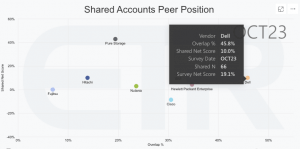With Dell APEX Cloud Platform for Red Hat OpenShift, the focus is Dell and Red Hat’s joint efforts in addressing hybrid cloud, multicloud environments. The collaboration aims to simplify cloud experiences for users, whether on-premises, in co-location, or with hyperscalers. This partnership is seen as crucial in providing a cohesive and supportive experience for customers transitioning to a multi-cloud operating model.
Introduction
As companies approach what Dell refers to as “multicloud by design”, meaning the purposeful adoption of multicloud, not something done by accident, they increasingly look for platforms that simplify their cloud operating models. With solutions like Dell APEX Cloud Platform for Red Hat OpenShift, organizations have ways to deploy multicloud technologies on-premises, in colocation, and in the hyperscale cloud to leverage the people, processes, and technologies that are familiar, with a more predictable cost structure.
Have we reached equilibrium?
The usage of public and private clouds is still shifting, but recent data shows that the market is becoming more balanced. We explored survey data from ETR, which tracks IT spending intentions quarterly. We specifically investigated firms in the S&P 500, a large portion of the market, and a bellwether segment. The following findings were notable:
- The percentage of public cloud usage is expected to grow from 43% today to 55% by January 2026.[1]
- The 55% target is five percentage points lower than the prediction ten months ago.
We believe this trend indicates the market is becoming more stable as workloads are being distributed more evenly between public and private clouds. The growth in cloud usage is primarily due to new workloads being added to existing cloud platforms rather than a lift and shift away from on-premises deployments. In addition, our research indicates that private clouds are closing the operating model gap with hyperscale clouds. As it becomes easier to manage on-premises or private clouds, net new cloud-native applications are being deployed in private clouds at a higher rate than previously anticipated.
Increasingly, while we continue to expect hyperscale clouds to grow faster than on-prem deployments, we believe customers are taking a more balanced approach to workload placement. Rather than a cloud-first mindset, organizations are aligning workload and platform characteristics to optimize cost, flexibility, service level, and governance objectives.

As cloud-native deployments become more widespread, organizations are seeking partners who can assist them across various deployment models. It’s worth noting that Dell infrastructure is installed in 46% of the 150 Red Hat OpenShift customer accounts[2] inside the ETR dataset, making Dell the dominant player in these accounts compared to other competitors. This information is represented in a chart that shows the net score or spending momentum on the y-axis and the presence in the dataset or overlaps in these accounts on the x-axis.
A rapidly emerging trend we see gaining momentum is the need to balance the location of AI and data. This involves either bringing the AI to the data or bringing the data to the AI. If the latter requires time-consuming or expensive data movement, the former is preferable. As organizations attempt to balance cost with functionality, many large organizations, using the S&P 500 as a proxy, understand what it takes to build and service cloud-native applications. They increasingly look at the economics and financials of doing “as-a-Service” themselves, either in owned data centers or colocation data centers.
Why Dell and Red Hat?
The collaboration for Dell and Red Hat started back in 2022 on the Dell APEX Cloud Platform for Red Hat OpenShift. But this is not the first time that Dell and Red Hat have collaborated, with the partnership going back decades. The Dell perspective is that this is far more than an operating system on a bare metal server. It’s about creating an experience. Red Hat has been about hybrid for a while now, and this is an extension of that. Hybrid is no longer just about consistent technology, it’s more about the experience. Although this is not a new partnership, the level of this partnership is what is new. Dell and Red Hat jointly engineered this solution to be a turnkey appliance with a simplify the experience.
But there’s a lot of really unique things about this platform. You know, a lot of what we talk about now is that this is so unique that we’re having to really explain the basics of it to a lot of people, because it is so unique, with nothing either of us have ever done before.
What was announced, and what is the impact on customers?
Dell and Red Hat have recently announced the expansion of the APEX Cloud Platform family by introducing Dell APEX Cloud Platform for Red Hat OpenShift. The aim of Dell’s “Ground-to-Cloud” concept is to provide organizations with a simplified cloud-operating model in their data centers or colocation, which can be easily combined with Red Hat OpenShift deployments in hyperscale cloud providers. This solution includes Red Hat OpenShift, automatically deployed and maintained on top of the Dell Universal Storage Layer, which allows organizations to have storage endpoints in the public cloud combined with consistent and centralized management across a comprehensive set of storage services, such as block, file, and data protection. This announcement goes beyond the traditional hyper-converged infrastructure (HCI) and presents a cloud operating model on top of the hardware and software from Dell and Red Hat, all integrated and supported together.
This announcement brings cloud-native operations, infrastructure, and applications, ensuring ease of deployment and day 2 operations for the APEX Cloud Platform for Red Hat OpenShift while taking advantage of the leadership role that Red Hat OpenShift has in Kubernetes. This is important because Red Hat’s developer and DevOps ecosystem are accustomed to the stack they already use for DevOps, such as Red Hat Ansible with its playbooks. This announcement is especially powerful for Dell and Red Hat’s channel partners. Organizations look for a better hybrid experience and are looking to channel partners. The benefits to the customers are control, visibility, supportability, and management of the entire deployment and universal storage layer via a SaaS control plane for managing on-premises and cloud-based storage. This provides operational consistency, which is essential to a cloud operating model, from on-premises to public cloud.
Our Perspective
We believe that the cloud operating model has become the primary way for organizations to procure, deploy, and manage infrastructure now and into future. With the emergence of many new “cloud-native” workloads that are split between on-premises and the public cloud, organizations will seek partners who can provide a Platform-as-a-Service (PaaS) environment across various deployment models such as public cloud, on-premises, colocation, and edge. Dell Technologies is well-positioned to meet this need, thanks to its PaaS layer and partner that can extend across all these different deployment models while integrating with the already-deployed storage. By partnering with Red Hat, Dell is providing choice for organizations seeking a cloud operating model with Red Hat OpenShift on-premises, in colocation, or in public clouds.
Other hyper-converged providers attempt to deploy PaaS layers that are simply a replication of on-premises technology to the public cloud. However, we believe that Dell Technologies and Red Hat have thoughtfully engineered a system that reimagines how private and public cloud deployments can work together seamlessly in one cloud operating model.
[1] ETR.ai Cloud ’23 Drill-Down Report, August 2023
[2] ETR.ai TSIS Shared Account Peer Position, October 2023
Disclosure: This theCUBE Research Analyst Brief was commissioned by Dell Technologies and is distributed under license from theCUBE Research. theCUBE Research is a research and advisory services firm that engages or has engaged in research, analysis, and advisory services with many technology companies, which can include those mentioned in this article. The author does not control any equity positions with any company mentioned in this article.
Analysis and opinions expressed herein are specific to the analyst individually, and data and other information that might have been provided for validation, not those of theCUBE Research or SiliconANGLE Media as a whole.



